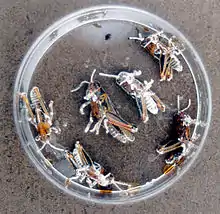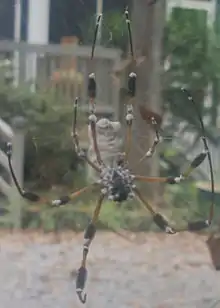Beauveria bassiana
Beauveria bassiana is a fungus that grows naturally in soils throughout the world and acts as a parasite on various arthropod species, causing white muscardine disease; it thus belongs to the entomopathogenic fungi. It is being used as a biological insecticide to control a number of pests such as termites, thrips, whiteflies, aphids and different beetles. Its use in the control of bedbugs[1] and malaria-transmitting mosquitos is under investigation.[2]
| Beauveria bassiana | |
|---|---|
 | |
| Grasshoppers killed by B. bassiana | |
| Scientific classification | |
| Kingdom: | Fungi |
| Division: | Ascomycota |
| Class: | Sordariomycetes |
| Order: | Hypocreales |
| Family: | Cordycipitaceae |
| Genus: | Beauveria |
| Species: | B. bassiana |
| Binomial name | |
| Beauveria bassiana (Bals.-Criv.) Vuill. (1912) | |
| Synonyms | |
| |
Discovery and name
The species is named after the Italian entomologist Agostino Bassi, who discovered it in 1815 as the cause of the muscardine disease which then led to carriers transmitting it by airborne means. It was formerly also known as Tritirachium shiotae. The name B. bassiana has long been used to describe a species complex of morphologically similar and closely related isolates. Rehner and Buckley [3] have shown that B. bassiana consists of many distinct lineages that should be recognized as distinct phylogenetic species and the genus Beauveria was redescribed with a proposed type for B. bassiana in 2011.[4] In light of this work and the known existence of cryptic species, it is important to characterise isolates used to develop biological insecticides.
Relation to Cordyceps and other fungi
Beauveria bassiana is the anamorph (asexually reproducing form) of Cordyceps bassiana. The latter teleomorph (the sexually reproducing form) has been collected only in eastern Asia.[5]
White muscardine disease
The insect disease caused by the fungus is a muscardine which has been called white muscardine disease. When the microscopic spores of the fungus come into contact with the body of an insect host, they germinate, penetrate the cuticle, and grow inside, killing the insect within a matter of days. Afterwards, a white mold emerges from the cadaver and produces new spores. A typical isolate of B. bassiana can attack a broad range of insects; various isolates differ in their host range. The factors responsible for host susceptibility are not known.

Beauveria bassiana parasitizing the Colorado potato beetle has been reported to be, in turn, the host of a mycoparasitic fungus Syspastospora parasitica.[6] This organism also attacks related insect-pathogenic species of the Clavicipitaceae.
Morphology of the fungus
In culture, B. bassiana grows as a white mould. On most common cultural media, it produces many dry, powdery conidia in distinctive white spore balls. Each spore ball is composed of a cluster of conidiogenous cells. The conidiogenous cells of B. bassiana are short and ovoid, and terminate in a narrow apical extension called a rachis. The rachis elongates after each conidium is produced, resulting in a long zig-zag extension. The conidia are single-celled, haploid, and hydrophobic.
Use in biological control of insects
Beauveria bassiana can be used as a biological insecticide to control a number of pests such as termites, whiteflies, and many other insects. Its use in the control of malaria-transmitting mosquitos is under investigation.[2] As an insecticide, the spores are sprayed on affected crops as an emulsified suspension or wettable powder or applied to mosquito nets as a mosquito control agent.
As a species, Beauveria bassiana parasitizes a very wide range of arthropod hosts. However, different strains vary in their host ranges, some having rather narrow ranges, like strain Bba 5653 that is very virulent to the larvae of the diamondback moth and kills only few other types of caterpillars. Some strains do have a wide host range and should, therefore, be considered nonselective biological insecticides. These should not be applied to flowers visited by pollinating insects.[7]
Known targets include:[8][9][10]
- Aphids
- Whiteflies
- Mealybugs
- Psyllids
- Chinch bug
- Lygus bugs
- Grasshoppers
- Stink bugs (Halyomorpha halys)[11]
- Thrips
- Termites
- Fire ants
- Flies
- Stem borers
- Fungal gnats
- Shoreflies
- Beetles
- Caterpillars
- Codling moth
- Douglas fir tussock moth
- European corn borer
- Invasive silkworms
- Apple clearwing moth[15]
- Mites
The fungus rarely infects humans or other animals, so it is generally considered safe as an insecticide. However, at least one case of human infection by B. bassiana has been reported in a person with a suppressed immune system.[16] Additionally, the spores may exacerbate breathing difficulties. Wagner and Lewis reported the ability of B. bassiana to grow as an endophyte in corn.[17]
A fungus attributed to be B. bassiana was observed to cause infections in a captive American alligator[18] and B. bassiana was implicated in causing a pulmonary disease in captive tortoises.[19][20] The reptiles were in captivity and under temperature stress which may explain their susceptibility to the fungus. When a tortoise was kept at 22°C and injected with 0.5 mL of 106 spores of B. bassiana into the lung, no mortality was observed, while a second contaminated tortoise died when kept only at 16°C.[21]
Preliminary research has shown the fungus is 100% effective in eliminating bed bugs exposed to cotton fabric sprayed with fungus spores. It is also effective against bed bug colonies due to B. bassiana carried by infected bugs back to their harborages. All subjects died within 5 days of exposure.[1]
Containment leak
In March 2013, genetically modified Beauveria bassiana was found in a number of research laboratories and greenhouses outside of a designated containment area at Lincoln University in Christchurch, New Zealand. The Ministry for Primary Industries investigated the leak.[22]
See also
- Biological insecticides
- Metarhizium spp. which cause "green muscardine" disease
References
| Wikimedia Commons has media related to Beauveria bassiana. |
- Barbarin, Alexis M.; Jenkins, Nina E.; Rajotte, Edwin G.; Thomas, Matthew B. (15 September 2012). "A preliminary evaluation of the potential of Beauveria bassiana for bed bug control" (PDF). Journal of Invertebrate Pathology. 111 (1): 82–85. doi:10.1016/j.jip.2012.04.009. PMID 22555012.
- Donald G. McNeil Jr., Fungus Fatal to Mosquito May Aid Global War on Malaria, The New York Times, 10 June 2005
- Rehner SA, Buckley E (2005). "A Beauveria phylogeny inferred from nuclear ITS and EF1-{alpha} sequences: evidence for cryptic diversification and links to Cordyceps teleomorphs". Mycologia. 97 (1): 84–98. doi:10.3852/mycologia.97.1.84. PMID 16389960.
- Rehner, Stephen A.; Minnis, Andrew M.; Sung, Gi-Ho; Luangsaard, J. Jennifer; Devotto, Luis; Humber, Richard A. (2011). "Phylogeny and systematics of the anamorphic, entomopathogenic genus Beauveria". Mycologia. 103 (5): 1055–1073. doi:10.3852/10-302. PMID 21482632.
- Li ZZ, Li CR, Huang B, Fan MZ (2001). "Discovery and demonstration of the teleomorph of Beauveria bassiana (Bals.) Vuill., an important entomogenous fungus". Chinese Science Bulletin. 46 (9): 751–3. doi:10.1007/BF03187215.
- Posada, F.; et al. (2004). "Syspastospora parasitica, a mycoparasite of the fungus Beauveria bassiana attacking the Colorado potato beetle Leptinotarsa decemlineata: a tritrophic association". J. Insect Sci. 4: 24. doi:10.1093/jis/4.1.24. PMC 528884. PMID 15861239.
- "EPA Factsheet". Retrieved 2006-12-14.
- "Cornell Extension Service". Archived from the original on 13 December 2006. Retrieved 2006-12-14.
- "University of Connecticut Extension". Archived from the original on 2006-09-01. Retrieved 2006-12-14.
- "University of Minnesota Extension". Archived from the original on 7 December 2006. Retrieved 2006-12-14.
- Gouli, Vladimir; Gouli, Svetlana; Skinner, Margaret; Hamilton, George; Kim, Jae Sue; Parker, Bruce L (February 2012). "Virulence of select entomopathogenic fungi to the brown marmorated stink bug, Halyomorpha halys (Stål) (Heteroptera: Pentatomidae)". Pest Management Science. 68 (2): 155–157. doi:10.1002/ps.2310. PMID 22223199.
- Mann, Andrew; Davis, Thomas (2020). "Plant secondary metabolites and low temperature are the major limiting T factors for Beauveria bassiana (Bals.-Criv.) Vuill. (Ascomycota: Hypocreales) growth and virulence in a bark beetle system". Biological Control. doi:10.1016/j.biocontrol.2019.104130.
- "Biocontrol: Fungus and Wasps Released to Control Emerald Ash Borer". Science News. ScienceDaily. 26 April 2011. Retrieved 3 February 2012.
- Un hongo acaba con el 75% del picudo rojo que afecta al conjunto del Palmeral de Elche (in Spanish)
- Cossentine, J. E.; Judd, G. J. R.; Bissett, J. D.; Lacey, L. A. (2010-01-01). "Susceptibility of apple clearwing moth larvae, Synanthedon myopaeformis (Lepidoptera: Sesiidae) to Beauveria bassiana and Metarhizium brunneum". Biocontrol Science and Technology. 20 (7): 703–707. doi:10.1080/09583151003690390. ISSN 0958-3157.
- Tucker DL, Beresford CH, Sigler L, Rogers K (November 2004). "Disseminated Beauveria bassiana infection in a patient with acute lymphoblastic leukemia". J. Clin. Microbiol. 42 (11): 5412–4. doi:10.1128/JCM.42.11.5412-5414.2004. PMC 525285. PMID 15528759.
- Wagner BL, Lewis LC (August 2000). "Colonization of corn, Zea mays, by the entomopathogenic fungus Beauveria bassiana". Appl. Environ. Microbiol. 66 (8): 3468–73. doi:10.1128/AEM.66.8.3468-3473.2000. PMC 92172. PMID 10919808.
- Jensen, J. M.; Robinson, B. E.; Bulmer, G. S. (July 1979). "Fatal Mycotic Pulmonary Disease of Captive American Alligators". Veterinary Pathology. 16 (4): 428–431. doi:10.1177/030098587901600405. ISSN 0300-9858. PMID 452316.
- Georg, Lucille K.; Williamson, W.M.; Tilden, Evelyn B.; Getty, Ruth E. (1962). "Mycotic pulmonary disease of captive giant tortoises due toBeauvaria bassianaandPaecilomyces fumoso-roseus". Medical Mycology. 2 (2): 80–86. doi:10.1080/00362176385190161. ISSN 1369-3786.
- Cabo, J. F. González; Serrano, J. Espejo; Asensio, M. C. Bárcena (March 1995). "Mycotic pulmonary disease byBeauveria bassianain a captive tortoise". Mycoses. 38 (3–4): 167–169. doi:10.1111/j.1439-0507.1995.tb00043.x. ISSN 0933-7407. PMID 7477096.
- Müller-Kögler, E. (December 1967). "Nebenwirkungen Insektenpathogener Pilze Auf Mensch und Wirbeltiere: Aktuelle Fragen". Entomophaga. 12 (4): 429–441. doi:10.1007/bf02376929. ISSN 0013-8959.
- "Genetically modified fungus leaked". 3 News NZ. March 20, 2013. Archived from the original on January 15, 2014. Retrieved March 20, 2013.
Further reading
- Luz C, Rocha LF, Nery GV, Magalhães BP, Tigano MS (March 2004). "Activity of oil-formulated Beauveria bassiana against Triatoma sordida in peridomestic areas in Central Brazil". Mem. Inst. Oswaldo Cruz. 99 (2): 211–8. doi:10.1590/S0074-02762004000200017. PMID 15250478.
- Prior C, Jollands P, Le Patourel G (1988). "Infectivity of oil and water formulations of Beauveria bassiana (Deuteromycotina; Hyphomycetes) to the cocoa weevil pest Pantorhytes plutus (Coleoptera: Curculionidae)". Journal of Invertebrate Pathology. 52 (1): 66–72. doi:10.1016/0022-2011(88)90103-6.